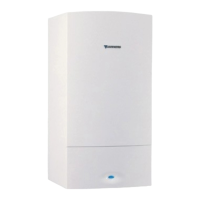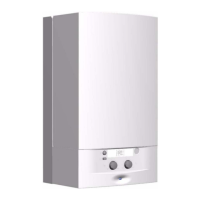B Always switch off the voltage
(fuses, LS switch) before
working on the electrical components.
splash (IP): Choose the cable entry hole according to
its diameter (see Fig. 12).
B Pull the mask down and remove it.
B Insert the cable through the hole in the stuffing box
and make the connections, according to Fig. 13.
B Loosen the screw and pull the cover forward to
remove it.
cable.
B For biphasic networks (IT network):
Fig. 11
the proximity of bathtubs or showers; domain 1 and
2, according to VDE 0100, part 701).
B The electrical connections are made through a separation
system with a distance of min. 3 mm between contact
elements (eg fuses, LS switches).
- HO5VV-F 3 x 0.75 mm2 (may not be used near
bathtubs or showers; range 1 and 2 according to
VDE 0100, part 701)
B For protection against water resulting from
The electrical connections must
comply with the regulations in force for
household electrical installations.
All adjustment, control and safety components are
connected and checked at the factory.
• The following cable types are recommended:
Danger: electric shock!
Install a resistor (code 8 900 431 516) between the - N
conductor and the connection of the protective
conductor, in order to achieve a sufficient ionization
current.
• For protection against water resulting from
14
B Cut the stuffing box according to the diameter
Opening the control panel
Fig. 10
Fig. 12
- HO5VV-F 3 x 1.0 mm2 (cannot be used in
splash (IP): Choose the cable passage hole according
to its diameter, Fig. 12.
Electrical connections
- NYM-I 3 x 1.5 mm2
B Earthing is required.
B The cable must be left at least 50 cm outside the
wall.
4.1 Connecting the device
i
6 720 610 828 RO (02.01)
4 Electrical connections
Machine Translated by Google
